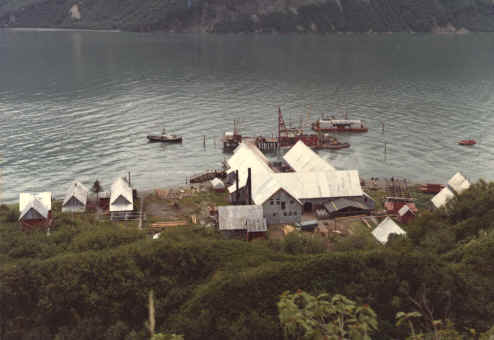
1927-1980
Friends of Snug Harbor, Alaska
Were you There?

1927-1980
The Book
SOCKEYE SUNDAY and other fish tales is not only a history of Snug Harbor and its passing parade of legends, but with a weaving of salmon fishing and land acquisition in the Cook Inlet area as well. Woven along with these histories are the wonderful tales of the people who made this scenario possible.
You'll meet real characters: Hank Kroll, "Mad Trapper", Sally Munger, Moose-meat John and Jack (Solomon) English, plus all the others, who by their daring and diligence made a living in Alaska and to some degree, tamed Cook Inlet. Their tales spiced the meals in the cannery's Blue Room and penetrated the smoky confines of our store's nightly bull sessions The store was built in 1917 by George Palmer, the Knik trader who built the original clam cannery at Snug for Chief Chikalusion and his people of Tyonek.
Mine was a ringside seat from 1946 until 1996. Husband Joe had been a one year old when his father Eric Fribrock first arrived in 1921 as foreman for Hemrich's cannery formerly Surf Packing. Eric's saga tells of keeping this cannery on remote Chisik Island producing and packing salmon, rescuing the stranded crews, getting them home again to Seattle after an early season telegram told of the bankruptcy of his employer. With only $10 remaining of his original $300 start-up stake, Eric's ingenuity, drive and resourcefulness produced a pack, paid the bills and actually paved the way for his becoming a partner in 1927 with Al Foster (Alitak) of the newly established Snug Harbor Packing Company. At age 16, Eric was a Swedish immigrant via Ellis Island His story is one that was repeated many times in the building of our great country. Eric's feelings and expectations as he set out on his life's adventure are worth telling.
The continuing story of Snug Harbor is in the tales of the people who gave it life: George Palmer (Palmer, Alaska) who built the original buildings, Eric Fribrock and Joe Fribrock who struggled to make it produce, the fishermen, the crews and Filipinos who provided the know-how. Cook Ralph Havestein, foreman Chris Johnson, beach boss Axel Norstedt and "mid-night John" Jensen, pile driver foreman, to name a few.
Snug was the spot geologists used as headquarters in their search for Cook Inlet oil. Pictographs in upper Tuxedni prove that the ancients were here and on an August night the passing Sputniks or a gossamer weather balloon are signs the present is at Snug, too. Rangers from surrounding Lake Clark National Park often made headquarters at Snug.
When Alaska became a state, the newsmen came to our outpost to interview us on how we liked being a state. We didn't! Statehood changed our lives. First traps were outlawed and Joe had to develop a gill net fleet and attract a set net fishery to support the cannery It was a challenge. Snug Harbor is a varied place. Earthquakes, volcanoes and weather had their effect. Return to these historic times as you read SOCKEYE SUNDAY and other fish tales.
Copyright ã1999 Dorothy B. Fribrock
Library of Congress Catalog Card Number 99-95070
International Standard Book Number 0-9674115-0-5 $32.50
To order the book SOCKEYE SUNDAY by Dorothy B. Fribrock:
Paper copies of the book are sold out.
Send $32.50 plus $7.00 for postage and handling for a total of 39.50
per book (PDF on CD)
Mail the total amount for your order (including sales tax if applicable) either check or money order to:
John Kistler
893 Wildwood Rd
Curtis, Washington 98538
Remember to include your mailing address so we can send your order to you.